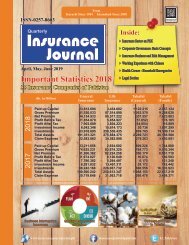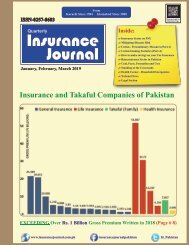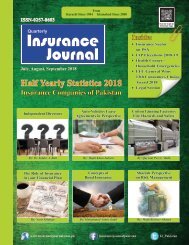Insurance Journal (2nd Quarter 2021)
You also want an ePaper? Increase the reach of your titles
YUMPU automatically turns print PDFs into web optimized ePapers that Google loves.
Guest Contribution
due to increased severe hailstorm
events, although reduced severity of
cold winters could mitigate losses.
Motor third party liability coverage
could theoretically be attacked by
injured parties claiming that carbon
dioxide emissions from vehicles have
lead to adverse climatic effects. Many
Engineering projects hits due to flood
and other natural causes result in
million of losses to insurance
companies. Aviation Hull claims may
increase over time due to increased
hailstorm and lightning strike losses.
Airlines and Product Manufacturers
could potentially face liability suits
over the perceived contribution of the
Airline industry to Climate Change.
The major drivers of climate and
weather-related losses are windstorm,
flood and other related events (escape
of water), both to commercial and
domestic property. So increase in
weather related claims may put
financial stress on some sectors of the
insurance industry.
Climate Change is already affecting
and will over time significantly affect
the incidence of natural conditions.
This will impact on property
insurance losses (with infrastructure
impacts increasing the business
i n t e r r u p t i o n c o m p o n e n t o f
losses)Direct and indirect physical
risks also have relevance to the asset
side of general and life insurance
balance sheets. For example, storms
and floods can directly impact upon
an insurer's investments into real
estate.
The physical risks from climate
change may affect the health and
mortality of the population, and
thereby impact the liabilities of health
and life insurers. At present, the
number of deaths due to natural
catastrophe in wealthy nations would
appear to be small compared to nonnatural
catastrophe perils. Increased
morbidity (ill-health and specifically
the rate of incidence of ill-health) and
mortality from severe heat waves, and
other indirect impacts of rising
temperatures such as the increase in
vector-borne diseases (i.e disease
transmitted by mosquitos, etc.), are
probably the most substantial threats
to health and life insurance liabilities.
Improved climate conditions for the
spread of vector-borne diseases like
malaria, dengue, Lyme disease,
encephalitis, and hantavirus or waterborne
illnesses like cholera,
cryptosporidiosis and toxoplasmosis
increase liabilities of health and life
insurers. enhanced mortality risks due
to natural disasters, including flash
floods; flooding and intensified
precipitation also can contaminate
waters and soils with pathogens,
hazardous chemicals and agricultural
waste. The potential for displacement
of populations as a result of these
events could also have public health
consequences increase liabilities of
health and life insurers;
Insurers and reinsurers have now
focused additional attention on the
possibility of indirect claims of this
kind, adopting practices such as
exclusions and increasing prices in
order to mitigate the risks they
present.
These liability risks could arise from
parties who have suffered loss and
damage from the physical or
transition risks from climate change
seeking to recover losses from others
who they believe may have been
responsible.
Employer's Liability: skin cancer
litigation and workers' compensation
claims are increasing.
Environmental Liability: corporate
liabilities may eventually arise from
claims against large emitters of
greenhouse gases.
D&O: Directors and Officers could
be sued where it can be shown they
have not managed their company's
contribution to, or exposure to the
effects of, Climate Change.
Climate Change will change the risks
faced by the customers of non-life
insurance companies, which gives an
opportunity to our industry as our
core competency and product
offering is the management of risk.
Potential impact climate change can
have on insurer solvency and the
availability and affordability of
insurance across all major categories.
Marine Insurance an interesting
implication of Climate Change is that
decreasing arctic ice is likely to lead
l e a d i n g t o n e w i n s u r a n c e
opportunities.
Insurance Journal April, May, June 2021
33
Find us at: www.insurancejournal.com.pk — www.facebook.com/insurancejournalpakistan

















